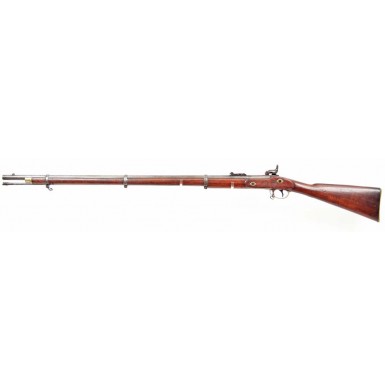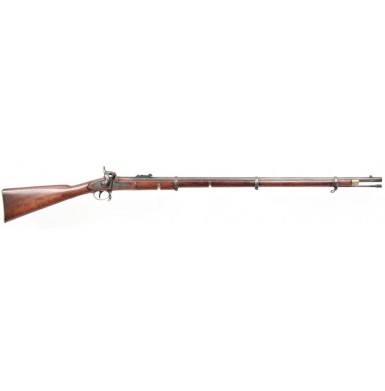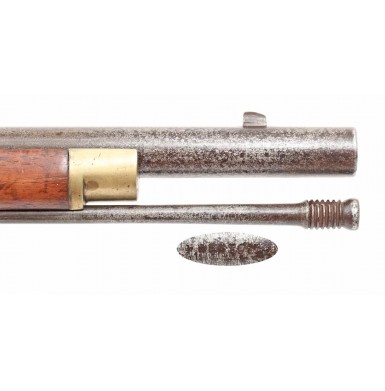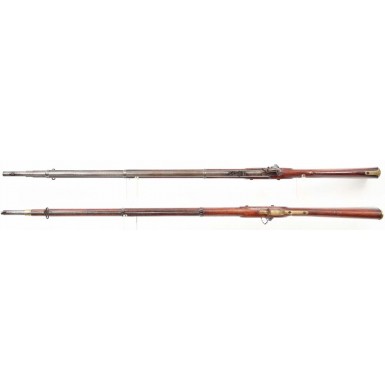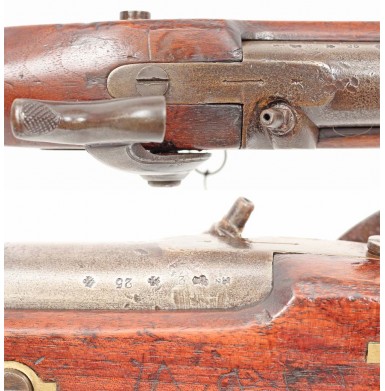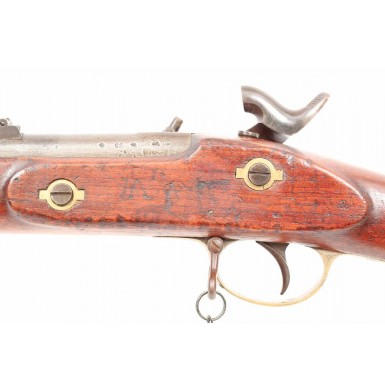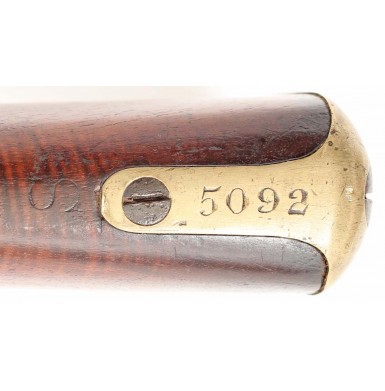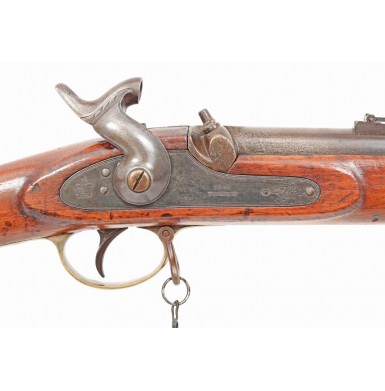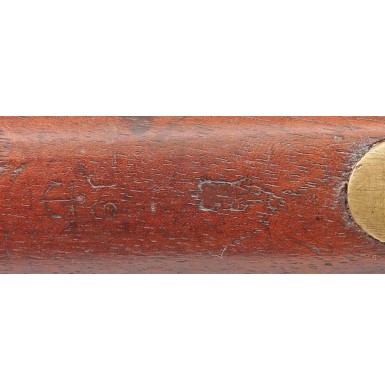Confederate Marked & Numbered P-1853 Enfield
- Product Code: FLA-2890-SOLD
- Availability: Out Of Stock
-
$1.00
The most iconic of the imported arms to see service with the Confederacy during the American Civil War is the British P-1853 Enfield Rifle Musket, marked with the Confederate J S / Anchor viewer’s mark of John Southgate, combined with an engraved Confederate inventory number on the tang of the brass buttplate. If a collector were to have only one true Confederate imported weapon in their collection, one of these Confederate marked Enfields would be the perfect addition. There is no more striking image than that of the ragged Confederate infantryman with a P-1853 Enfield Rifle Musket in his hands, doggedly defending his belief in states rights and defending his boarders from the perceived Northern invasion.
During the early days of the American Civil War, Confederate purchasing agents did a splendid job of tying up contracts for the British P-1853 Enfield Rifle Musket, which was truly one of the most advanced and well made military long arms of the day. According to Confederate Chief of Ordnance Josiah Gorgas’s February 3, 1863 summary of imported arms, some 70,980 “Long Enfield Rifles” were purchased from the beginning of the war through the end of 1862. These numbers only account for Confederate central government purchases, and do not include those P-1853s purchased by the individual Confederate states or by speculators seeking to sell them within the Confederacy. The majority of these arms were purchased from the firms of S. Isaac, Campbell & Company (who relied on John Edward Barnett & Sons to deliver many of those arms) or Sinclair, Hamilton & Company, who often routed their sales through S. Isaac, Campbell & Co as well. Additional P-1853s were purchased from William Grazebrook of Liverpool, who made his first sales to Confederate purchasing agent Caleb Huse within 30 days of the opening of the war. Sinclair, Hamilton & Company entered into several contracts with the Confederacy to deliver P-1853 Enfield Rifle Muskets, with the typical contract terms requiring 30,000 arms to be delivered over a six month period. During the course of the war, Sinclair, Hamilton & Company appears to have received as many as five of these contracts for P-1853 Enfield Rifle Muskets from the Confederate central government. The second of these contracts for 30,000 P-1853 “Long Enfields’ is the one represented by the guns with the JS / (ANCHOR) mark, along with the engraved buttplate tang inventory numbers. These inventory numbers ran from 1-10,000 in three series (to date no gun with a 10,000 number is known, although theoretically they existed). The first series had no suffix after the number, while the second series of 10,000 had an “A” suffix under the inventory number and the third series of 10,000 had a “B” suffix. These numbered guns represent the October 1861 contract with Sinclair, Hamilton & Company that is referred to in Confederate documents as the “Second Contract”. This contract required the 30,000 Enfields to be delivered between October of 1861 and April of 1862. At least two identified “B” suffix guns with 3-digit inventory numbers have been determined to have been issued in Corinth, MS immediately prior to the battle of Shiloh on April 6-7 of 1862. Thus is it clear that the contract time line for production and delivery was closely followed, and the Confederacy did a good job delivering arms through the Union blockade during the first year of the war. Sinclair, Hamilton & Company acquired their arms through “Five Furnishers”. These were well-established gun making firms that were able to fill the large Sinclair, Hamilton & Company orders in a reasonable period of time. The “five furnishers’ were the long time London gunmakers EP Bond and Parker, Field & Co, and James Kerr. Kerr apparently received a tiny portion of the contract (only 500 guns) due to his relationship with the London Armoury Company. Archibald Hamilton of Sinclair, Hamilton & Company was the managing director of The London Armoury Company, and James Kerr (of Kerr revolver fame) was London Armoury Company’s manager. The balance of the guns were delivered by the Birmingham based firms of C.W. James and W.C. Scott & Son. The furnishers often marked the guns that were delivered under tis contract with a large single letter on the upper comb of the stock, just forward of the buttplate tang. The guns were marked with a B for Bond, an F for Parker, Field & Co, a J for James, a K for Kerr and an S for Scott & Son. A sixth single letter mark, P has been noted on extant Confederate Enfields from this contract. This mark was previously thought to be an alternate mark for Parker, Field & Company. However, more recent examination of extant examples and the other associated marks on those guns has revealed that this was the mark of Francis Preston of Manchester, England. Preston’s relationship within the contracting circle is not clear, but he delivered many socket bayonets for the numbered guns of this contract, and may have received a small sub-contract to provide long arms as well. No period documents have shown that Preston delivered the guns directly to Sinclair, Hamilton & Company, so it is most likely that his guns were sub-contracted by James or Scott, who delivered the majority of the guns. An October 31, 1861 dated letter from Sinclair, Hamilton & Co. notes that the contract was divided between the furnishers as follows: 8,000 guns from Scott & Son, 10,000 from CW James, 6,000 from E.P. Bond, 5,500 from Parker, Field & Co and 500 from James Kerr. This indicates that the guns delivered by CW James (the largest supplier) represented about 33% of the total delivery under this contract, Scott & Sons about 25%, Bond about 20% and Parker Field about 18% and the guns from Kerr represented less than 2% of the deliveries. An extensive database comprised of more than two decades of collected information related to Confederate purchased Enfields contains approximately 250 numbered P-1853 Enfield rifle muskets (not counting state purchased guns). Of those guns, the large majority (well more than half) are numbered guns with no suffix, representing about 74% of the recorded samples. A-suffix guns represent about 19% of the recorded examples, while B-suffix guns represent about 7% of surviving examples that are recorded. To date, less than 50 A-suffix and less than 20 B-suffix P-1853 Enfields are known to exist. The reason for the paucity of these arms is not clear, but it may simply be the result of attrition and the arms having been used up. With B-suffix guns (which would have theoretically been delivered later than the no suffix or “A” guns), the lack of extant examples may be an indication of the early successes experienced by the Union’s Atlantic Blockading Squadron. Recorded numbers show a good distribution of engraved numbers from two digits through the mid 2XXX range. Then there is then a nearly 4,000 number gap in the database that seems to indicate that a large number of the “B-guns’ in the 25XX to 62XX range may well be on the bottom of the Atlantic ocean. “A suffix” guns, although uncommon and with few examples to study, show a nice even distribution through the entire numbering sequence. This suggests that their scarcity today is the result of them having seen hard use, rather than having been dumped overboard while a Confederate blockade runner tried to elude a pursuing US Naval vessel.
The P-1853 Enfield Rifle Musket offered here is a classic example of a Confederate marked and imported musket that clearly saw use in the field. The gun is in about VERY GOOD+ to NEAR FINE condition and is marked in the wood behind the trigger guard with the desirable J S / (ANCHOR) mark. The buttplate tang is engraved with the inventory number 5092, indicating that this gun was right in the middle of the first group of 10,000 muskets to be delivered under the 2nd Sinclair, Hamilton & Company contract., and was likely one of the earliest numbered Enfields to arrive on southern soil. The gun bears a very crisp S furnishers mark, indicating that is was delivered by W.C. Scott & Sons of Birmingham. The firm of William & Charles Scott was established in Birmingham in 1840 and added the “& Son” portion of their moniker sometime during the latter portion of 1861. Like most Birmingham gun makers, they were located at a number of different addresses while they were in business. During the Civil War era, the firm was located at two different addresses; 94 Bath Street (1855-1863) and Bagot Street (1864-1895). The gunmakers gained their greatest fame during the latter half of the 19th century when their double-barreled shotguns were considered to be some of the finest made in the world. The company merged with Philip Webley & Son in 1897, establishing the extremely successful gunmaking firm of Webley & Scott. During the Civil War, Scott & Son delivered thousands of P-1853 Enfield rifle muskets to the Confederacy, primarily through Sinclair, Hamilton & Company. Scott produced guns are known with a variety of Confederate import marks, in addition the JS/Anchor and numbered buttplates from the 2nd Sinclair, Hamilton & Company contract.
As previously noted, this Confederate Enfield is in VERY GOOD+ to NEAR FINE condition, especially for an early war dated Confederate purchased and used Enfield. The lock is marked TOWER / 1861 forward of the hammer and with the typical British “Crown” mark to the rear of the hammer. The gun is a commercial one and bears no British military marks at all, which is typical of guns bound for export markets. The upper left of the breech is marked with the usual Birmingham commercial View and Proof marks, along with a pair of 25 gauge marks (indicating .577 caliber). There is also an S /2 stamped to the rear of the proof marks. The top of the breech bears an indistinguishable trademark or maker’s logo. The interior of the lock bears few marks other than the number 42 over the mainspring, along with an S / S. This appears to be a Scott assembly mark, as the mark is present on the barrel as well, and may be on the stock flat, although that mark is not completely legible. This mark seems to have been used as a mating mark instead of the more commonly encountered “Roman numeral” style file slash mating marks. The bottom of the barrel is marked with the name of the barrel maker, HENRY CLIVE, as well as with the initials T.F. (setter up”) and with a punch dot, along with the alphanumeric combination 8 J O. The ramrod channel is marked with a pair of initials that appear to read F P (Francis Preston possibly”) or might be F F. The barrel of the gun has a mostly smooth smoky gray, salt and pepper patina, with the bottom of the barrel showing a slightly darker, bluer patina. The metal of the barrel is quite smooth, but does show some scattered light surface oxidation along with scattered peppering and oxidized age discoloration. There is some light to moderate scattered pinpricking on the barrel well. As would be expected, the breech and bolster area do show light flash pitting, which is typical on a combat used percussion rifle musket. The bore of the musket is in about GOOD+ to NEAR VERY GOOD condition. The bore of the gun is somewhat dark, with a seasoned appearance and retains strong 3-groove, progressive depth rifling. The bore shows what appears to be evenly distributed light to moderate pitting along its entire length, however, some of it may actually be dirt and debris that would clean out. The action of the gun is mechanically excellent and functions crisply on all positions. The lock has the same basic dusky blue-gray patina as the rest of the gun, with some darker mottling, suggesting strong traces of the original case colored finish. The lock markings are quite legible, although the lock does show some lightly scattered pitting on its surface, mostly on the forward portion. There is an original, period snap cap (nipple protector) attached to the rear sling swivel. The protector is in very good condition and while a nice, original accessory; it is probably not original to the gun. The brass furniture has a medium golden patina, which is very attractive. The Confederate inventory number 5092 is neatly engraved on the tang. The long-range rear sight is complete and fully functional, but is a later replacement (probably from a Snider Enfield). While it looks great and the patina matches the gun well, it is not exactly correct, and is mentioned for exactness in the description. The original front sight/bayonet lug is present near the muzzle of the musket. Both sling swivels are present, but both are probably later replacements as the swivels were regularly lost, removed or broken on Confederate Enfields. The rear swivel appears to be an original one, but the upper swivel is probably a very high-grade modern reproduction. The three original Palmer pattern clamping barrel bands are all in place on the musket. The lower and middle bands retain their original tension screw doughnut-like keepers at their ends. The upper band tension screw is original, but the keeper is lost to the ages. The original ramrod, which was numbered to the gun, is missing in action. This is typical with numbered Enfields, as less than 10% of extant examples retain a numbered ramrod (let alone the original matching one). The ramrod that now accompanies the gun is an original, P-1853 ramrod from the period, which is full length and retains most of its original threads at the end. The ramrod was produced by Francis Preston of Manchester, and bears the name PRESTON to the rear of the jag head on the slightly swelled portion of the shank. The stock is in about NEAR FINE condition as well. The stock retains very strong edges and fairly sharp lines and does not appear to have been sanded. The stock is solid, complete and full-length, with no breaks or significant damage noted. A very minor, internal crack was noted inside the lock mortise, in the wood along the upper edge of the lock. The crack is not visible from the exterior and has an old glue repair making it quite stable. Although the minor crack is invisible and solid it is mentioned for exactness. The stock bears the expected JS / (ANCHOR) inspection mark in the wood behind the triggerguard, along with a less legible (CROWN / B / S A / T mark, indicating that the maker was a member of the Birmingham Small Arms Trade. The JS / (ANCHOR) mark is quite legible and clear, but also shows good age and light wear. There is a makers name stamped in the toe of the stock as well, but it is not completely legible. It appears to read SCOTT & SON, but may be that of another Birmingham gunmaker. A somewhat indistinguishable mark is stamped at the tail of the stock flat, opposite the lock. I believe that it was an S / 2, as found on the barrel and inside the lock of the musket. There are also some illegible initials lightly carved on the stock flat, a feature common on CS used and carried arms.
Overall, this is a great looking example of a completely authentic Confederate imported and used Enfield Rifle Musket that saw field service. The gun has the most desirable and well known of Confederate import marks, a legible JS / (ANCHOR). It also has a wonderful engraved inventory number. This gun was clearly a very early arrival in the Confederacy that was likely on the field well before the beginning of the 1862 spring and summer campaign seasons. The pinpricking around the breech and pitting within the bore clearly shows that this gun saw service and fought for Southern independence during the course of the war. Somehow, through all of that use and potential for combat damage, the gun managed to survive in extremely nice and relatively complete original condition. With less than “ of the numbered Confederate Enfields being delivered by Scott, and with less than 1% of those 30,000 guns having survived to be in collections today, this is simply an incredibly scarce example of a Confederate purchased gun. If you have ever wanted to own a completely correct and honest Confederate used P-1853 Enfield Rifle Musket, that really saw service and fought the war, this would be a great addition to you collection. This gun is an iconic piece of history, which was no doubt a witness to some of the most horrific moments in the American Civil War, and is just as Confederate as any Richmond made rifle musket, and at a much more reasonable price.
SOLD

